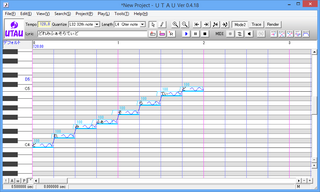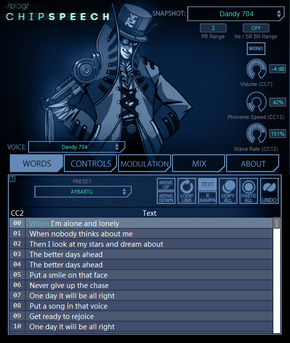Speech synthesis is the artificial production of human speech. A computer system used for this purpose is called a speech synthesizer, and can be implemented in software or hardware products. A text-to-speech (TTS) system converts normal language text into speech; other systems render symbolic linguistic representations like phonetic transcriptions into speech. The reverse process is speech recognition.
A voicemail system is a computer-based system that allows people to leave a recorded message when the recipient is unable to answer the phone. The caller is prompted to leave a message and the recipient can retrieve said message at a later time.

NOAA Weather Radio (NWR), also known as NOAA Weather Radio All Hazards, is an automated 24-hour network of VHF FM weather radio stations in the United States that broadcast weather information directly from a nearby National Weather Service office. The routine programming cycle includes local or regional weather forecasts, synopsis, climate summaries or zone/lake/coastal waters forecasts. During severe conditions the cycle is shortened into: hazardous weather outlooks, short-term forecasts, special weather statements or tropical weather summaries. It occasionally broadcasts other non-weather related events such as national security statements, natural disaster information, environmental and public safety statements, civil emergencies, fires, evacuation orders, and other hazards sourced from the Federal Communications Commission's (FCC) Emergency Alert System. NOAA Weather Radio uses automated broadcast technology that allows for the recycling of segments featured in one broadcast cycle into another and more regular updating of segments to each of the transmitters. It also speeds up the warning transmitting process.

A telecommunications relay service, also known as TRS, relay service, or IP-relay, or Web-based relay service, is an operator service that allows people who are deaf, hard of hearing, deafblind, or have a speech disorder to place calls to standard telephone users via a keyboard or assistive device. Originally, relay services were designed to be connected through a TDD, teletypewriter (TTY) or other assistive telephone device. Services gradually have expanded to include almost any real-time text capable technology such as a personal computer, laptop, mobile phone, PDA, and many other devices. The first TTY was invented by deaf scientist Robert Weitbrecht in 1964. The first relay service was established in 1974 by Converse Communications of Connecticut.
SpeechWorks was a company founded in Boston in 1994 by speech recognition pioneer Mike Phillips and Bill O'Farrell. The Boston-based company developed and supported speech-related computer software. Originally known as Applied Language Technologies, SpeechWorks went public in 2000 and tripled its value. It was acquired by Scansoft in 2003. ScanSoft acquired Nuance in 2005, and changed its name to Nuance Communications.

Software Automatic Mouth, or S.A.M., is a speech synthesis program developed by Mark Barton and sold by Don't Ask Software. The program was released for the Atari 8-bit family, Apple II, and Commodore 64. Released in 1982, it was one of the first commercial all-software voice-synthesis programs.

An intercom, also called an intercommunication device, intercommunicator, or interphone, is a stand-alone voice communications system for use within a building, small collection of buildings or portably within a small coverage area, which functions independently of the public telephone network. Intercoms are generally mounted permanently in buildings and vehicles, but can also be detachable and portable. Intercoms can incorporate connections to public address loudspeaker systems, walkie talkies, telephones, and other intercom systems. Some intercom systems incorporate control of devices such as signal lights and door latches.

SpeechFX, Inc. offers voice technology for mobile phone and wireless devices, interactive video games, toys, home appliances, computer telephony systems and vehicle telematics. SpeechFX speech solutions are based on the firm’s proprietary neural network-based automatic speech recognition (ASR) and Fonix DECtalk, a text-to-speech speech synthesis system (TTS). Fonix speech technology is user-independent, meaning no voice training is involved.

Votrax International, Inc., or just Votrax, was a speech synthesis company located in the Detroit, Michigan area from 1971 to 1996. It began as a division of Federal Screw Works from 1971 to 1973. In 1974, it was given the Votrax name and moved to Troy, Michigan and, in 1980, split off of its parent company entirely and became Votrax International, Inc., which produced speech products up until 1984.

A dictation machine is a sound recording device most commonly used to record speech for playback or to be typed into print. It includes digital voice recorders and tape recorder.

Speech-generating devices (SGDs), also known as voice output communication aids, are electronic augmentative and alternative communication (AAC) systems used to supplement or replace speech or writing for individuals with severe speech impairments, enabling them to verbally communicate. SGDs are important for people who have limited means of interacting verbally, as they allow individuals to become active participants in communication interactions. They are particularly helpful for patients with amyotrophic lateral sclerosis (ALS) but recently have been used for children with predicted speech deficiencies.

eSpeak is a free and open-source, cross-platform, compact, software speech synthesizer. It uses a formant synthesis method, providing many languages in a relatively small file size. eSpeakNG is a continuation of the original developer's project with more feedback from native speakers.

UTAU is a Japanese singing synthesizer application created by Ameya/Ayame (飴屋/菖蒲). This program is similar to the VOCALOID software, with the difference being it is shareware instead of under a third party licensing.
Loquendo is an Italian multinational computer software technology corporation, headquartered in Torino, Italy, that provides speech recognition, speech synthesis, speaker verification and identification applications. Loquendo, which was founded in 2001 under the Telecom Italia Lab, also had offices in United Kingdom, Spain, Germany, France, and the United States.
This article deals with music software created for the Amiga line of computers and covers the AmigaOS operating system and its derivates AROS and MorphOS and is a split of main article Amiga software. See also related articles Amiga productivity software, Amiga programming languages, Amiga Internet and communications software and Amiga support and maintenance software for other information regarding software that run on Amiga.
NeoSpeech Inc. is an American company that specializes in text-to-speech (TTS) software for embedded devices, mobile, desktop, and network/server applications. NeoSpeech was founded by two speech engineers in Fremont, California, US, in 2002. NeoSpeech is privately held, headquartered in Santa Clara, California.
Plogue Art et Technologie, Inc. is an incorporated company based in Montreal, Quebec, Canada that develops music software including Bidule, chipsounds, Alter/Ego and chipspeech.

Chipspeech is a vocal synthesizer software which was created by Plogue with the goal of recreating 1980s synthesizers.

Alter/Ego (アルター・エゴ) is a free real-time vocal synthesizer software which was created by Plogue.

Dennis H. Klatt was an American researcher in speech and hearing science. Klatt was the pioneer of computerized speech synthesis and created an interface which allowed for speech for non-expert users for the first time. Prior to his work, non-verbal individuals would need specialist support to be able to speak at all. Stephen Hawking used a version of this speech synthesizer, based on Klatt's own voice, and which Hawking chose to keep even after others became available.













